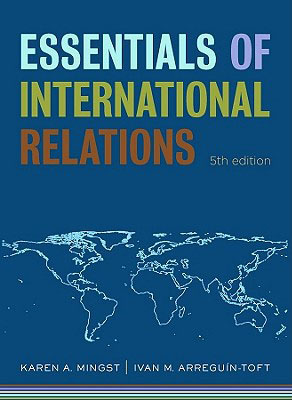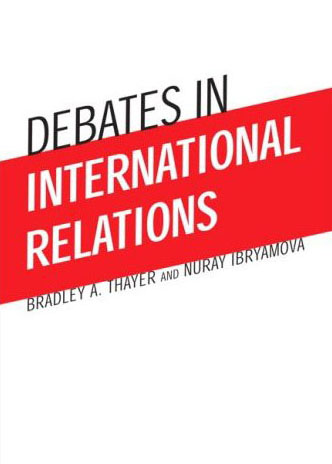
 |
||||||||
| American Institutions Requirement: This course satisfies the American Institutions category of the Dixie State College General Education requirements. | ||||
| Texts | |||||
Required Texts |
|||||
| Karen Mingst and Ivan Arreguin-Toft, Essentials of International Relations, 5th Edition, ISBN 978-0-393-93529-5 |  |
||||
Bradley A. Thayer and Nuray V. Ibryamova, Debates in International Relations 978-0-205-56812-3 |
 |
||||
| Companion Website | |||||
|
|||||
| Back to top | |||||
| Gifts: Gift from students to the teacher can be misinterpreted. While the thought will be appreciated, Mr. Green cannot accept gifts under any circumstances. I would be better for all concerned if they were not offered. | ||||
| Class Interruptions: Please turn off your cell phones, radios, walkmans, and alarms such as watches and palm pilots during class. Electronic disturbances of this class will not be allowed. | ||||
| Political Science 22 00 Course Objectives | ||||
| 1. 2. 3. 4. |
Students will identify and understand the major topical divisions in International Relations including the nature of politics and political science, realism and idealism, the nature of the state, international law and institutions, and international security, economic, human rights and environmental issues. Students will effectively analyze decisions and processes that effect International Relations. Students will argue and write analytically and coherently about significant issues and problems in International Relations. Students will learn about the politics of International Relations by reading significant authors and authoritative texts. |
|||
| Back to top | ||||
| Policies | ||||
http://new.dixie.edu/reg/syllabus Use the link to find the 1) the semester schedule, 2) information on student resources including the library, disability resource center, IT help, testing center etc., 3) policy statements including academic integrity,, disruptive behavior, absences for college functions and disability accommodation, and 4) D-Mail. |
||||
"An eminent mathematician once remarked that he was never satisfied with his knowledge of a mathematical theory until he could explain it to the next (person) he met in the street. This is hardly exaggerated; however, we must remember that a satisfactory explanation entails duties on both sides." |
||||
| Course Attendance Policy | ||||
Missing class will involve costs. There will is no such thing as an excused absence for any reason. As a matter of policy, I will not to go over or in any other way make up lectures or other activities for students who miss class. I will make no adjustments nor will I allow exceptions to policies regarding missing papers, quizzes, tests, or exams when the reason is discretionary such as a vacation, the deer hunt, or a visit home. This said, consideration will be given for rescheduling class activities in the event 1) of school sponsored activities, illness, or accident and 2) if consultation if done privately [in Mr. Green’s office and not in front of the class] before the scheduled time of the activities. |
||||
| Student Duties | ||||
You must commit to a fifteen week program of rigorous study. For the average C+ to B-) Dixie College student, this course will demand two hours out-of-class study for every hour we meet in class or 6 hours a week. This means careful reading: in order to perform well on exams and class assignments you will have to work with your textbook, as opposed to just reading it. It also means you will do college level writing. Finally, you must be willing to consider viewpoints different from your own and to express your opinion in class. |
||||
| Back to top | ||||
| Grades | ||||
The course grade will be assessed using the following formula: |
||||
•
|
Written Exams (grades x 40%)
exam grade = (midterm exam grade x 40%) + (final exam grade x 60%) Timed Tests (grade x 30%) test grade = total test points divided by the class’ high score Debate (grade x 30%) debate grade = ( average debate paper grade x 50%) + (debate attendance grade x 50%) |
|||
| Grade Creation | ||||
All grades, except the journal, will be determined using one of the following two methods. First, the score on the will be divided by the high score in the class. If the score is within 95% of the high, the resulting grade will be an A. The breakdown will then descend by percentages of the high until the a score that is 60% of the high earns a D- (see the % of Grade conversion box). However, if the average grade for the class, calculated using the first method, is less than a C, at the instructor’s discretion a second method might be used in place the first. Under this second methodology, instead of dividing by the high score, the instructor will divide until the average grade for the class is set at or near C. Further adjustments will be made if there are several sections of the class and significantly differentiated denominators between the classes. If there are multiple sections of the class that use the same measuring instrument, as when all section take the same test, the average will calculated from all sections rather than each class individually. |
||||
| Back to top | ||||
Grading Percentages Breakdown |
|||||
Above 95% |
= A | ||||
| 90% to 94.9% | = A- | ||||
87% to 89.9% |
= B+ | ||||
| 83% to 86.9% | = B | ||||
| 80% to 82.9% | = B- |
||||
| 77% to 79.9% | = C+ |
||||
| 73% to 76.9% | = C |
||||
| 70% to 72.9% | = C- |
||||
| 67% to 69.9% | = D+ |
||||
| 63% to 66.9% | = D |
||||
| 60% to 62.9% | = D- |
||||
| Below 60% | = F |
||||
| Return to the top | |||||
| Written Exams | ||||
Two major written exams will be given during the semester accounting for 40% of the grade.grade is a composite of a midterm exam grade, worth 40% of the exam grade, and a final exam, worth 60% of the exam grade. Students must take both exam to pass the class. Nature of the Exams Possible Midterm Exam Questions
Possible Final Exam Questions
Exam Grading
Mechanics: Use correct grammar and spelling. For your information, a chart showing Mr. Green’s Writing Mechanics and Punctuation Codes is included on page 9. Once each exam is scored, its grade will be determined using the procedure described in the grade creation section on page 2 above. Exam Grade Options Option One: the midterm will count as 40% of the exam grade while the final exam will count as 60% of the exam grade. Option Two:The midterm grade will be thrown out and the final exam grade alone will be the exam grade.
Exam Time Period Early or Late Final Exam |
||||
| Back to top | ||||
| Timed Tests | ||||
The grade on four tests, based on the reading of Karen Mingst and Ivan Arreguin-Toft, Essentials of International Relationswill constitute 30% of the final grade. The Timed Tests Test Rules The Practice Tests The practice test arsenal also includes is one practice timed test to correspond to each of the three timed tests. Each contains 60 questions like the timed tests, is timed for 60 minutes like the timed tests, and covers the same chapters as its corresponding timed test, Unlike the timed test, its score does not count toward the test grade. These practice tests should allow each student to thoroughly test their knowledge of the material before taking the actual timed test. |
||||
|
|
||||
| Back to top | ||||
| Debates | ||||||
Debate will account for 30% of the grade.This grade come from two activities: the grades on the debate paper grade will account for 50% and the attendance grade counts for 50% Debate Paper Assignment The purpose of the paper is to create a summary and response to the reading so that other members of the class will be understand the issues raised by readings they have not read. This will be accomplish by a brief summary or both articles and a longer discussion of two reasons why one of the authors had the strongest argument. The summaries should be about one paragraph each while the critique and opinion section should constitute the bulk of the paper. One the day the paper is due bring two copies of the paper. The due dates are on the schedule. (See the semester schedule that was passed out on the first day.) Give one copy to Mr. Green at the beginning of the class. The second is available when each student reads their paper to the class. Two class periods will be allocated for listening to each set of papers and debating the issues they raise. Debate Paper Content Grade
Debate Paper Formatting
Unacceptable Papers
An unacceptable paper can be fixed and resubmitted by the next class period after it is turned back. If it is turned in any later, it will be treated as a late paper. Debate Paper Grades Debate Paper Rewrites Debate Paper Due Date and Late Papers Attendance and Participation Grade Second, 25 points are awarded for coming on time with the debate paper for each Tuesday debate session each . This section worth 100 points. 5 points will be subtracted for each and every failure to be prepared to read the paper when class starts. Finally, 15 points will be awarded for reading the assigned paper to the class at the assigned time slot. (Time slots will be assigned for each session on the first day of debate) 5 points will be subtracted from this section for having to read the paper as a time other than the one assigned as the time slot. This adds another 60 possible points. The Syllabus Quiz The Pre-Test and the Post Test Calculating the Grade |
||||||
| Back to top | ||||||
| Writing Aids | |||||
The following set of writing guides were developed by Dr. Allan Payne of the Dixie College English faculty to help students compose papers that are unified, coherent, and correct. When Mr. Green grades your paper, he will assume that you have read and incorporated the standards these guides contain. |
|||||
| Guide 1 | A two page list of key writing terms with their definitions. Mr. Green uses most of these term when explaining his assignment. | ||||
| Guide 2 | A one page graphic example of a properly structured paper and a one page sample paper that follows the example. | ||||
| Guide 3 | A six page guide to basic grammar and punctuation rules. | ||||
| Back to top | |||||